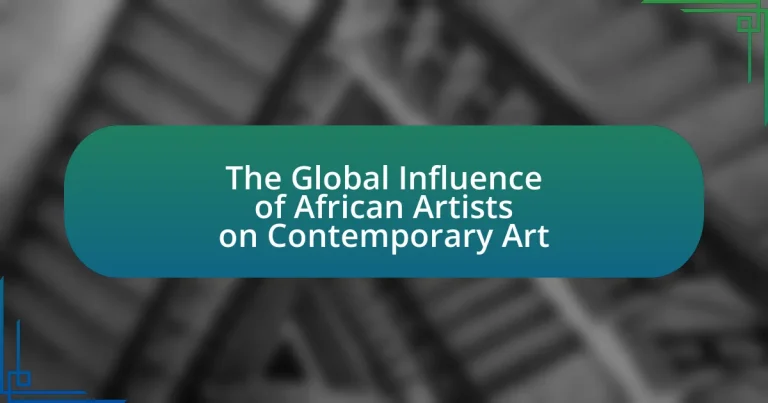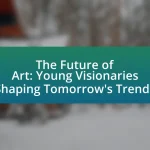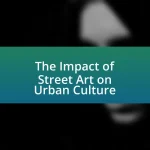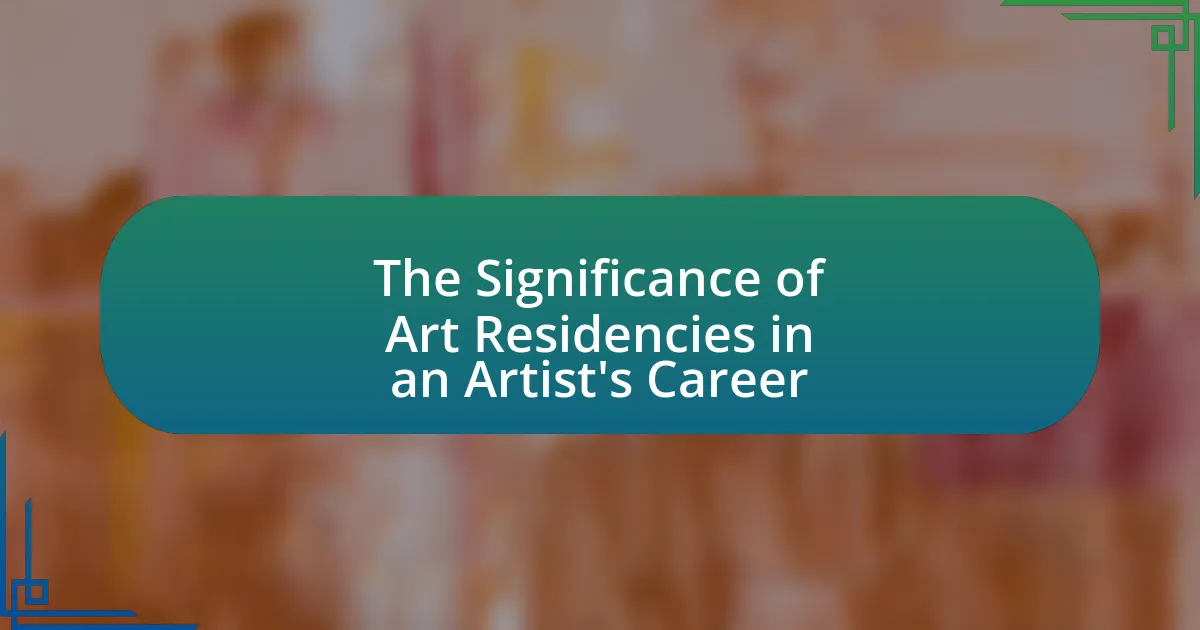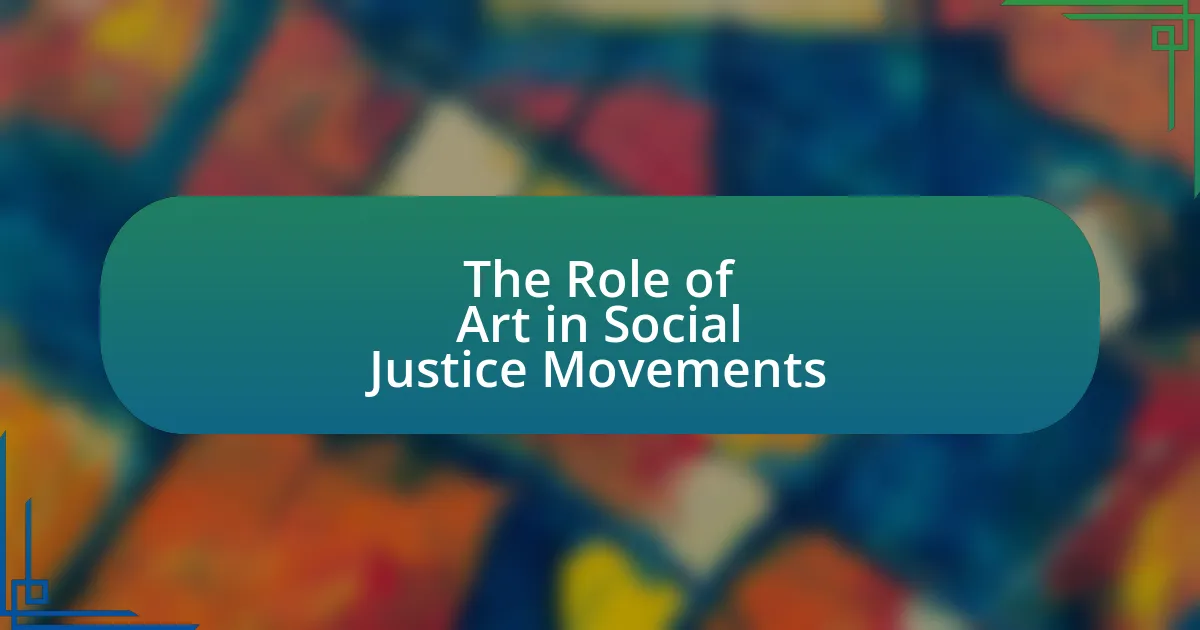The article examines the significant global influence of African artists on contemporary art, highlighting their unique perspectives, cultural narratives, and innovative techniques that enrich the global art landscape. It discusses how artists like El Anatsui and Yinka Shonibare address themes such as identity, colonialism, and globalization, while also emphasizing the importance of platforms like the Venice Biennale in amplifying their visibility. Key characteristics of African art, including vibrant colors and storytelling, are explored, along with the challenges faced by African artists in gaining international recognition. The article also addresses the role of collaborations and technology in enhancing artistic expression and the future trends shaping African contemporary art.
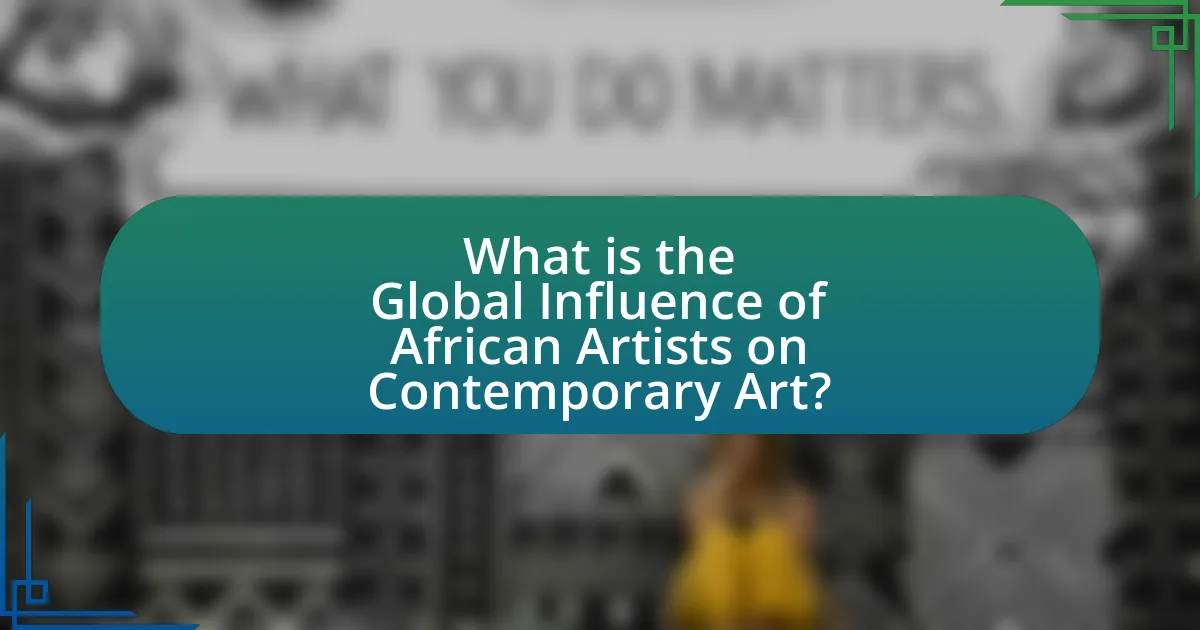
What is the Global Influence of African Artists on Contemporary Art?
The global influence of African artists on contemporary art is significant, as they introduce unique perspectives, cultural narratives, and innovative techniques that challenge and enrich the global art landscape. African artists, such as El Anatsui and Yinka Shonibare, utilize traditional materials and methods while addressing contemporary themes like identity, colonialism, and globalization, thereby fostering cross-cultural dialogues. The rise of platforms like the Venice Biennale and the Dakar Biennale has further amplified their visibility, showcasing African art to international audiences and influencing global art trends. Additionally, the incorporation of African aesthetics into mainstream art practices has led to a broader appreciation of diverse artistic expressions, reshaping the narratives within contemporary art.
How have African artists shaped contemporary art movements globally?
African artists have significantly shaped contemporary art movements globally by introducing diverse perspectives, techniques, and themes that challenge traditional narratives. Their work often incorporates elements of cultural heritage, social commentary, and political critique, which resonate with global audiences. For instance, artists like El Anatsui and Yinka Shonibare utilize materials and motifs that reflect African history and identity, influencing the discourse around post-colonialism in art. Additionally, the rise of the African art market, exemplified by events like the 1-54 Contemporary African Art Fair, has facilitated greater visibility and appreciation of African artists, further integrating their contributions into the global art scene. This integration is evidenced by the inclusion of African artists in major exhibitions and collections worldwide, such as the Venice Biennale and the Tate Modern, highlighting their pivotal role in contemporary art.
What are the key characteristics of African art that influence contemporary practices?
Key characteristics of African art that influence contemporary practices include the use of vibrant colors, symbolic representation, and a strong emphasis on community and storytelling. Vibrant colors are often employed to convey emotions and cultural significance, while symbolic representation allows artists to communicate complex ideas and traditions. The focus on community and storytelling reflects the communal nature of African societies, where art serves as a medium for sharing history and values. These elements have been integrated into contemporary art, as seen in the works of artists like El Anatsui and Yinka Shonibare, who blend traditional African aesthetics with modern techniques to address global themes.
How do cultural narratives from Africa impact global art trends?
Cultural narratives from Africa significantly impact global art trends by introducing diverse perspectives, themes, and aesthetics that challenge Western-centric views. African art often incorporates storytelling, spirituality, and community, which resonate with contemporary global movements emphasizing inclusivity and social justice. For instance, the rise of Afrofuturism, which blends African culture with science fiction, has influenced artists worldwide, leading to exhibitions like “The Afrofuturism Exhibit” at the Museum of Contemporary Art in Chicago. This trend illustrates how African narratives inspire innovation and dialogue in global art, fostering a richer, more varied artistic landscape.
Why is the recognition of African artists important in the contemporary art scene?
The recognition of African artists is crucial in the contemporary art scene because it fosters diversity and enriches global artistic discourse. African artists bring unique perspectives and cultural narratives that challenge dominant art paradigms, thereby promoting inclusivity. For instance, the rise of artists like El Anatsui and Yinka Shonibare has highlighted the significance of African heritage and contemporary issues, influencing both collectors and institutions. Furthermore, according to a 2020 report by Art Basel and UBS, the African art market has seen significant growth, indicating a rising appreciation for African creativity and its impact on global art trends. This recognition not only validates the contributions of African artists but also encourages a broader understanding of art’s role in society.
What role do African artists play in challenging traditional art narratives?
African artists play a crucial role in challenging traditional art narratives by redefining cultural expressions and questioning established norms. They often incorporate indigenous techniques, themes, and perspectives that contrast with Western-centric art histories, thereby promoting a more inclusive understanding of art. For instance, artists like El Anatsui and Yinka Shonibare utilize materials and motifs that reflect African heritage while addressing global issues such as colonialism and identity. This approach not only disrupts conventional art discourse but also encourages dialogue about the complexities of cultural representation and authenticity in contemporary art.
How does the visibility of African artists contribute to diversity in the art world?
The visibility of African artists significantly enhances diversity in the art world by introducing unique cultural perspectives and narratives that challenge dominant Western art paradigms. This visibility allows for a broader representation of experiences and histories, enriching the global art discourse. For instance, exhibitions like the Venice Biennale have increasingly featured African artists, showcasing their work to international audiences and fostering cross-cultural dialogue. Additionally, the rise of platforms such as 1-54 Contemporary African Art Fair highlights the contributions of African artists, further integrating their voices into the mainstream art scene. This integration not only diversifies artistic expression but also promotes inclusivity, allowing for a more comprehensive understanding of contemporary art.
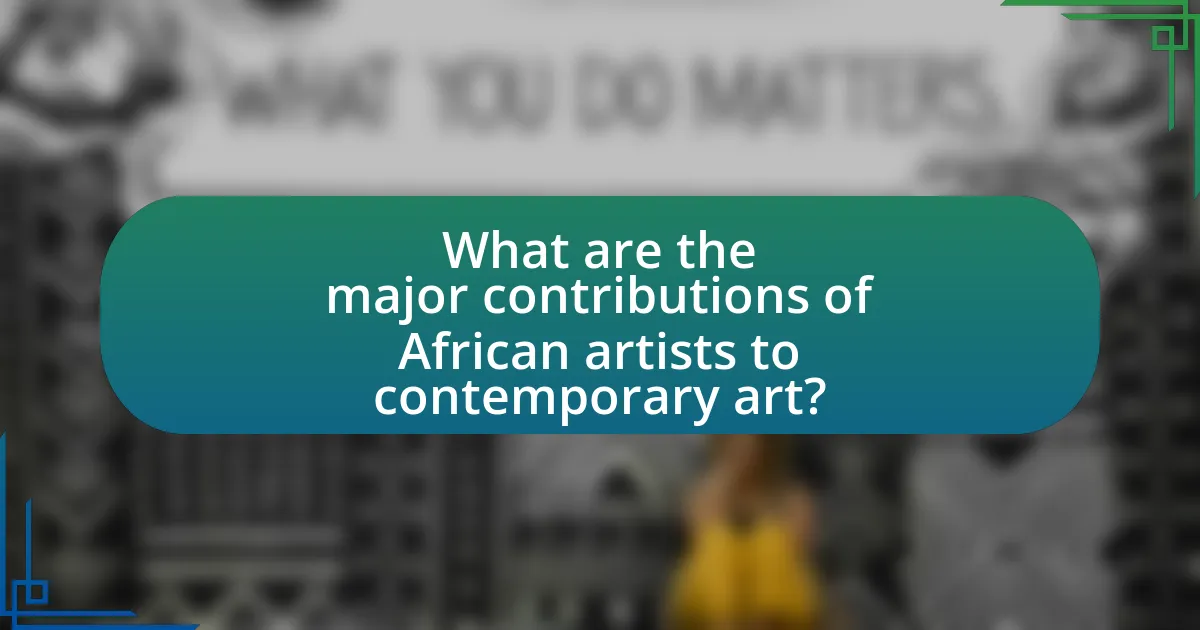
What are the major contributions of African artists to contemporary art?
African artists significantly contribute to contemporary art through innovative techniques, diverse cultural narratives, and the incorporation of traditional practices into modern contexts. Their work often challenges colonial narratives and addresses social issues, as seen in the art of El Anatsui, whose large-scale installations made from recycled materials comment on consumerism and waste. Additionally, artists like Yinka Shonibare use historical references to explore identity and post-colonial themes, while others, such as Wangechi Mutu, blend various media to address gender and race. The global art market increasingly recognizes these contributions, with African artists gaining representation in major exhibitions and galleries, thereby influencing contemporary art discourse worldwide.
Which African artists have made significant impacts on the global art landscape?
African artists who have made significant impacts on the global art landscape include El Anatsui, Yinka Shonibare, and Wangechi Mutu. El Anatsui is renowned for his large-scale sculptures made from recycled materials, which challenge perceptions of waste and value, and his work has been exhibited in major institutions worldwide, including the Venice Biennale. Yinka Shonibare is known for his exploration of colonialism and identity through vibrant textiles and installations, with his work featured in prominent exhibitions such as the Tate Modern. Wangechi Mutu’s mixed-media art addresses themes of gender, race, and the environment, earning her recognition in international art circles, including the Brooklyn Museum. These artists exemplify the diverse narratives and innovative practices that have reshaped contemporary art on a global scale.
What are the notable works of these artists that exemplify their influence?
Notable works of African artists that exemplify their influence include “The Holy Book” by El Anatsui, which showcases the use of recycled materials to comment on consumerism and cultural identity. Another significant work is “The Wishing Tree” by Yinka Shonibare, which addresses colonialism and cultural hybridity through the use of Dutch wax fabric. Additionally, “The Black Woman” series by Zanele Muholi highlights issues of race and gender, emphasizing the experiences of black LGBTQ+ individuals in South Africa. These works collectively demonstrate the profound impact of African artists on contemporary art by challenging narratives and expanding the discourse around identity and culture.
How do these artists address social and political issues through their art?
African artists address social and political issues through their art by using visual storytelling to highlight injustices, cultural identity, and historical narratives. For instance, artists like El Anatsui and Yinka Shonibare incorporate materials and techniques that reflect their cultural heritage while critiquing colonialism and globalization. El Anatsui’s large-scale installations made from recycled materials comment on consumerism and environmental degradation, while Shonibare’s work often explores themes of identity and race through the use of Dutch wax fabric, symbolizing the complexities of post-colonial identity. These approaches not only provoke thought but also engage audiences in conversations about pressing social issues, demonstrating the power of art as a medium for activism and awareness.
How do collaborations between African and international artists enhance contemporary art?
Collaborations between African and international artists enhance contemporary art by fostering cross-cultural exchange and innovation. These partnerships allow for the blending of diverse artistic techniques, themes, and perspectives, resulting in unique artworks that reflect a global narrative. For instance, the collaboration between Nigerian artist El Anatsui and international institutions has led to the creation of large-scale installations that incorporate traditional African materials and contemporary practices, showcasing the richness of African heritage while appealing to a global audience. Such interactions not only elevate the visibility of African art on the world stage but also challenge and expand the definitions of contemporary art, making it more inclusive and representative of varied cultural experiences.
What are some successful examples of cross-cultural collaborations?
Successful examples of cross-cultural collaborations include the partnership between African artists and international institutions, such as the collaboration between the African Artists’ Foundation and the British Council, which has fostered artistic exchange and showcased African art globally. Another notable example is the “Africa Now” exhibition at the Saatchi Gallery in London, which featured contemporary African artists and highlighted their work alongside Western artists, promoting cultural dialogue. Additionally, the collaboration between Nigerian artist El Anatsui and various global museums has resulted in significant installations that merge traditional African craftsmanship with contemporary themes, demonstrating the impact of cross-cultural artistic partnerships. These collaborations not only enhance visibility for African artists but also enrich the global art scene by integrating diverse perspectives and practices.
How do these collaborations foster innovation in artistic expression?
Collaborations among artists foster innovation in artistic expression by merging diverse cultural perspectives and techniques. This blending of influences often leads to the creation of unique art forms that challenge traditional boundaries. For instance, the collaboration between African artists and their global counterparts has resulted in innovative practices that incorporate indigenous materials and contemporary themes, reflecting a fusion of heritage and modernity. Such partnerships not only enhance creativity but also expand the audience’s understanding of art, as seen in exhibitions that showcase collaborative works, which often receive critical acclaim and attract wider audiences.
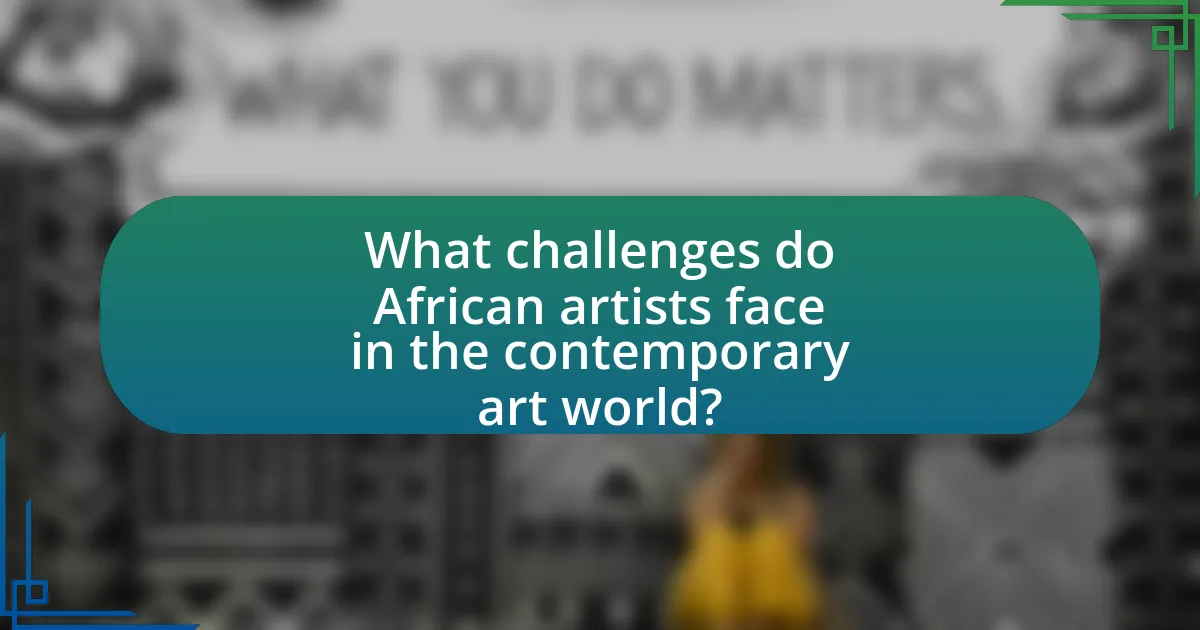
What challenges do African artists face in the contemporary art world?
African artists face significant challenges in the contemporary art world, including limited access to funding, inadequate infrastructure, and a lack of representation in global art markets. These obstacles hinder their ability to showcase their work internationally and secure financial support for their projects. For instance, a report by the African Arts Trust highlights that many African artists struggle to find galleries willing to exhibit their work, which is often undervalued compared to Western art. Additionally, the absence of established art institutions in many African countries further complicates the development of local talent and the promotion of their art on a global scale.
How do economic and political factors affect the work of African artists?
Economic and political factors significantly influence the work of African artists by shaping their access to resources, opportunities, and platforms for expression. Economic instability can limit funding for art projects, restrict access to materials, and reduce market opportunities, which directly impacts the ability of artists to create and showcase their work. For instance, in countries experiencing economic downturns, artists may struggle to find patrons or buyers, leading to a reliance on alternative forms of income, such as teaching or commercial work, which can dilute their artistic focus.
Politically, the environment in which artists operate can either foster creativity or impose restrictions. In nations with oppressive regimes, artists often face censorship, limiting their ability to critique societal issues or express their identities freely. Conversely, supportive political climates can encourage artistic innovation and collaboration, as seen in countries like South Africa post-apartheid, where artists have thrived in a more open and democratic society. The interplay of these economic and political factors ultimately shapes the themes, mediums, and visibility of African artists on both local and global stages.
What barriers exist for African artists in gaining international recognition?
African artists face several barriers in gaining international recognition, including limited access to global art markets, inadequate representation in international exhibitions, and cultural biases. Limited access to global art markets restricts opportunities for African artists to showcase their work, as many lack the financial resources and networks necessary to participate in international fairs and galleries. Inadequate representation in major art exhibitions, such as the Venice Biennale, often results in a lack of visibility for African artists, further hindering their recognition. Additionally, cultural biases can lead to the undervaluation of African art in the global context, where Western-centric narratives dominate the art discourse. These factors collectively contribute to the challenges African artists encounter in achieving international acclaim.
How do these challenges influence the themes and styles of their work?
Challenges faced by African artists, such as socio-political instability and economic constraints, significantly influence the themes and styles of their work. These artists often incorporate elements of their cultural heritage, addressing issues like identity, colonialism, and resilience, which reflect their lived experiences. For instance, the use of traditional motifs and storytelling techniques in contemporary art serves to bridge the gap between past and present, allowing for a deeper exploration of personal and collective narratives. Additionally, the necessity to adapt to limited resources often leads to innovative techniques and materials, fostering unique artistic expressions that challenge conventional art forms. This interplay between adversity and creativity ultimately enriches the global art landscape, showcasing the profound impact of African artists on contemporary art.
What strategies can African artists employ to overcome these challenges?
African artists can employ collaboration, digital platforms, and cultural storytelling to overcome challenges. Collaboration with other artists and organizations can enhance visibility and provide access to resources, as seen in initiatives like the African Art Fair, which connects artists with global audiences. Utilizing digital platforms allows artists to showcase their work internationally, reaching wider audiences without geographical limitations; for instance, social media has enabled artists to gain recognition and sell their work globally. Additionally, cultural storytelling through their art can resonate with diverse audiences, fostering a deeper understanding and appreciation of African heritage, as demonstrated by artists like El Anatsui, whose work reflects African narratives while appealing to global art markets.
How can networking and community support enhance their visibility?
Networking and community support can significantly enhance the visibility of African artists by creating platforms for collaboration and exposure. When artists engage with networks, they gain access to opportunities such as exhibitions, workshops, and mentorship programs, which can showcase their work to broader audiences. For instance, initiatives like the African Art Fair have successfully connected artists with collectors and curators, increasing their recognition in the global art market. Furthermore, community support fosters a sense of belonging and shared identity, allowing artists to amplify their voices and narratives, which can resonate more deeply with diverse audiences. This interconnectedness not only elevates individual artists but also enriches the cultural landscape, making African art more prominent on the international stage.
What role do art institutions play in supporting African artists?
Art institutions play a crucial role in supporting African artists by providing platforms for visibility, resources for development, and opportunities for networking. These institutions, such as galleries, museums, and cultural organizations, often curate exhibitions that highlight African art, thereby increasing its recognition on a global scale. For instance, the 2017 Venice Biennale featured a significant number of African artists, showcasing their work to an international audience and fostering cross-cultural dialogue. Additionally, art institutions frequently offer grants, residencies, and educational programs that empower African artists to develop their skills and expand their creative practices. This support is vital for the sustainability of the art community in Africa, as it helps to cultivate talent and promote cultural heritage.
What are the future trends for African artists in contemporary art?
Future trends for African artists in contemporary art include increased global visibility, innovative use of technology, and a focus on social and political themes. African artists are gaining recognition on international platforms, with exhibitions in major art fairs and museums, which enhances their influence and reach. The integration of digital mediums, such as virtual reality and social media, allows artists to engage with broader audiences and experiment with new forms of expression. Additionally, many African artists are addressing pressing social issues, such as identity, migration, and climate change, reflecting the continent’s diverse narratives and experiences. This trend is supported by initiatives like the African Art Fair and the rise of art collectives that promote collaboration and cultural exchange.
How is technology influencing the work of African artists today?
Technology is significantly influencing the work of African artists today by providing new platforms for creation, distribution, and engagement. Digital tools such as graphic design software, social media, and online marketplaces enable artists to reach global audiences, showcase their work, and sell directly to consumers. For instance, platforms like Instagram and Etsy have allowed African artists to gain visibility and connect with international buyers, leading to increased sales and recognition. Additionally, the use of digital art forms, including animation and virtual reality, is expanding the creative possibilities for artists, allowing them to experiment with new mediums and styles. This shift is evidenced by the rise of digital art exhibitions and online art fairs that feature African artists, demonstrating the growing integration of technology in their artistic practices.
What emerging themes are likely to shape the future of African contemporary art?
Emerging themes likely to shape the future of African contemporary art include identity, globalization, and technology. Artists are increasingly exploring personal and collective identities, reflecting diverse cultural narratives and experiences. Globalization influences the exchange of ideas and styles, allowing African artists to engage with international art movements while maintaining local relevance. Additionally, technology plays a crucial role, with digital platforms enabling broader visibility and new forms of artistic expression, such as digital art and virtual exhibitions. These themes are supported by the growing presence of African artists in global art markets and institutions, highlighting their impact on contemporary art discourse.
